Influence of Hemp Shives Size on Hygro-Thermal and Mechanical Properties of a Hemp-Lime Composite
Abstract
:1. Introduction
2. Materials and Methods
2.1. Mix Design
2.2. Sample Preparation
2.3. Density and Total Porosity
2.4. Water Absorptivity
2.5. Capillary Uptake
2.6. Thermal Conductivity
2.7. Vapor Permeability
2.8. Specific Heat
- Inner atmosphere: argon 20 ml/min,
- Heating rate: 1 K/min,
- Temperature range: 35–75 °C.
2.9. Compressive Strength
2.10. Flexural Strength
3. Results and Discussion
3.1. Density and Total Porosity
3.2. Water Absorptivity
3.3. Capillary Uptake
3.4. Thermal Conductivity
3.5. Vapor Permeability
3.6. Specific Heat
3.7. Compressive Strength
3.8. Flexural Strength
4. Conclusions
- The difference in densities between FHS and THS samples are minor. Samples with fine shives possess a slightly higher density and total porosity than samples with thick shives.
- Regardless of the mixture, the composites are characterized by high mass absorptivity (above 100%). The biggest differences in the results between the two composites are visible in the initial period of the study. Composites with fine shives are characterized by higher and faster absorption of water.
- In the case of capillary uptake, the composite containing longer hemp shives (THS) absorbed more water and the amount of water absorbed after 24 h was higher by about 21% than in the case of FHS.
- Composites containing fine shives are characterized by a higher thermal conductivity (by about 6%) than composites with thick hemp shives.
- Water vapor permeability results of THS and FHS composites were close, which suggests that it is not strongly dependent on shives’ size.
- Both composites possess similar specific heat. Slightly higher values were obtained for the THS composite.
- Both composites behave differently under compressive load. The arrangement of the shives under the influence of compaction determines whether different composite structures can be obtained. In the case of THS it was not possible to establish the maximum destructive force. Comparing the initial behavior of the samples under load (with a displacement of 5 mm), a greater strength, by about 20%, was demonstrated by the composite inflicting incorporating fine shives.
- Flexural strength of the THS composite was higher by about 37%, than the FHS composite. Samples of FHS composites showed greater homogeneity of results and behavior under increasing load compared to THS.
Author Contributions
Funding
Acknowledgments
Conflicts of Interest
References
- Williams, J.; Lawrence, M.; Walker, P. The influence of constituents on the properties of the bio-aggregate composite hemp-lime. Constr. Build. Mater. 2018, 159, 9–17. [Google Scholar] [CrossRef]
- Grudzińska, M.; Brzyski, P. The Occurrence of Thermal Bridges in Hemp-Lime Construction Junctions. Period. Polytech. Civ. Eng. 2019, 63, 377–387. [Google Scholar] [CrossRef]
- Walker, R.; Pavía, S.; Mitchell, R. Mechanical properties and durability of hemp-lime concretes. Constr. Build. Mater. 2014, 61, 340–348. [Google Scholar] [CrossRef]
- Balčiūnas, G.; Vėjelis, S.; Vaitkus, S.; Kairytė, A. Physical Properties and Structure of Composite Made by Using Hemp Hurds and Different Binding Materials. Procedia Eng. 2013, 57, 159–166. [Google Scholar] [CrossRef] [Green Version]
- Diquéloua, Y.; Gourlay, E.; Arnaud, L.; Kurek, B. Influence of binder characteristics on the setting and hardening of hemp lightweight concrete. Constr. Build. Mater. 2016, 112, 506–517. [Google Scholar] [CrossRef]
- Nguyen, T.T.; Picandet, V.; Carre, P.; Lecompte, T.; Amziane, S.; Baley, C. Effect of compaction on mechanical and thermal properties of hemp concrete. Eur. J. Environ. Civ. Eng. 2010, 14, 545–560. [Google Scholar] [CrossRef]
- Nguyen, T.T.; Picandet, V.; Amziane, S.; Baley, C. Influence of compactness and hemp hurd characteristics on the mechanical properties of lime and hemp concrete. Eur. J. Environ. Civ. Eng. 2009. [Google Scholar] [CrossRef]
- Bourdot, A.; Moussa, T.; Gacoin, A.; Maalouf, C.; Vazquez, P.; Thomachot-Schneider, C.; Bliard, C.; Merabtine, A.; Lachi, M.; Douzane, O.; et al. Laboratory Characterization of a hemp-based agro-material: Influence of starch ratio and hemp shive size on physical, mechanical, and hygrothermal properties. Energy Build. 2017, 153, 501–512. [Google Scholar] [CrossRef]
- Stevulova, N.; Kidalova, L.; Junak, J.; Cigasova, J.; Terpakova, E. Effect of hemp shive sizes on mechanical properties of lightweight fibrous composites. Procedia Eng. 2012, 42, 496–500. [Google Scholar] [CrossRef] [Green Version]
- Stevulova, N.; Kidalova, L.; Cigasova, J.; Junak, J.; Sicakova, A.; Terpakova, E. Lightweight Composites Containing Hemp Hurds. Procedia Eng. 2013, 65, 69–74. [Google Scholar] [CrossRef] [Green Version]
- Arnaud, L.; Gourlay, E. Experimental study of parameters influencing mechanical properties of hemp concretes. Constr. Build. Mater. 2012, 28, 50–56. [Google Scholar] [CrossRef]
- Brzyski, P.; Suchorab, Z. Capillary uptake monitoring in lime-hemp-perlite composite using the time domain reflectometry sensing technique for moisture detection in building composites. Materials 2020, 13, 1677. [Google Scholar] [CrossRef] [PubMed] [Green Version]
- Walker, R.; Pavía, S. Moisture transfer and thermal properties of hemp–lime concretes. Constr. Build. Mater. 2014, 64, 270–276. [Google Scholar] [CrossRef]
- Mazhoud, B.; Collet, F.; Pretot, S.; Chamoin, J. Hygric and thermal properties of hemp-lime plasters. Build. Environ. 2016, 96, 206–216. [Google Scholar] [CrossRef]
- Brzyski, P.; Grudzińska, M.; Majerek, D. Analysis of the occurrence of thermal bridges in several variants of connections of the wall and the ground floor in construction technology with the use of a hemp-lime composite. Materials 2019, 12, 2392. [Google Scholar] [CrossRef] [Green Version]
- Delhomme, F.; Hajimohammadi, A.; Almeida, A.; Jiang, C.; Moreau, D.; Gan, Y.; Wang, X.; Castel, A. Physical properties of Australian hurd used as aggregate for hemp concrete. Mater. Today Commun. 2020, 24, 100986. [Google Scholar] [CrossRef]
- Polish Committee for Standardization. Building Lime. Definitions, Specifications and Conformity Criteria; PN-EN 459-1: 2015-06; Polish Committee for Standardization: Warsaw, Poland, 2015. [Google Scholar]
- Polish Committee for Standardization. Testing Hardened Concrete—Part 7: Density of Hardened Concrete; PN-EN 12390-3:2019-07; Polish Committee for Standardization: Warsaw, Poland, 2019. [Google Scholar]
- Polish Committee for Standardization. Natural Stone Test Methods Determination of Water Absorption at Atmospheric Pressure; PN-EN 13755:2008; Polish Committee for Standardization: Warsaw, Poland, 2008. [Google Scholar]
- Polish Committee for Standardization. Natural stone test methods. In Determination of Water Absorption Coefficient by Capillarity; PN-EN 1925:1999; Polish Committee for Standardization: Warsaw, Poland, 1999. [Google Scholar]
- European Committee for Standardization. Thermal Insulation—Determination of Steady-State Thermal Resistance and Related Properties—Guarded Hot Plate Apparatus; ISO 8302:1991; European Committee for Standardization: Geneva, Switzerland, 1991. [Google Scholar]
- European Committee for Standardization. Hygrothermal Performance of Building Materials and Products—Determination of Water Vapour Transmission Properties—Cup Method; ISO 12572:2016; European Committee for Standardization: Geneva, Switzerland, 2016. [Google Scholar]
- Huang, P.; Latif, E.; Chang, W.S.; Ansell, M.P.; Lawrence, M. Water vapour diffusion resistance factor of Phyllostachys edulis (Moso bamboo). Constr. Build. Mater. 2017, 41, 216–221. [Google Scholar] [CrossRef] [Green Version]
- Brigitte de Bruijn, P.; Jeppsson, K.H.; Sandin, K.; Nilsson, C. Mechanical properties of lime–hemp concrete containing shives and fibres. Biosyst. Eng. 2009, 103. [Google Scholar] [CrossRef]
- Sassoni, E.; Manzi, S.; Motori, A.; Montecchi, M.; Canti, M. Novel sustainable hemp-based composites for application in the building industry: Physical, thermal and mechanical characterization. Energy Build. 2014, 77, 219–226. [Google Scholar] [CrossRef]
- Polish Committee for Standardization. Methods of Testing Cement. Determination of Strength; PN-EN 196-1:2016-07; Polish Committee for Standardization: Warsaw, Poland, 2016. [Google Scholar]
- Rahim, M.; Douzane, O.; Tran Le, A.D.; Promis, G.; Laidoudi, B.; Crigny, A.; Dupre, B.; Langlet, T. Characterization of flax lime and hemp lime concretes: Hygric properties and moisture buffer capacity. Energy Build. 2015, 88, 91–99. [Google Scholar] [CrossRef]
- Rahim, M.; Douzane, O.; Tran Le, A.D.; Promis, G.; Langlet, T. Characterization and comparison of hygric properties of rape straw concrete and hemp concrete. Constr. Build. Mater. 2016, 102, 679–687. [Google Scholar] [CrossRef]
- Barclay, M.; Holcroft, N.; Shea, A.D. Methods to determine whole building hygrothermal performance of hemp-lime buildings. Build. Environ. 2014, 80, 204–212. [Google Scholar] [CrossRef] [Green Version]
- Collet, F.; Pretot, S. Thermal conductivity of hemp concretes: Variation with formulation, density and water content. Constr. Build. Mater. 2014, 65, 612–619. [Google Scholar] [CrossRef] [Green Version]
- Suchorab, Z.; Majerek, D.; Brzyski, P.; Sobczuk, H.; Raczkowski, A. Estimation of water absorption coefficient using the TDR method. AIP Conf. Proc. 2017, 1866, 40038. [Google Scholar] [CrossRef]
- Collet, F.; Prétot, S.; Chamoin, J.; Lanos, C. Hydric characterization of sprayed hempcrete. In Proceedings of the 4th International Building Physics Conference, Istanbul, Turkey, 15–18 June 2009. [Google Scholar]
- Tran Le, A. Etude des Transferts Hygrothermique Dans le Beton de Chanvre et Leur Application au Batiments. Ph.D. Thesis, De l’Université de Reims Champagne-Ardenne, Reims, France, 2011. [Google Scholar]
- Grelat, A. Utilisation des Matériaux Renouvelables en Parois de Maisons Individuelles à Ossature bois. Rapport Final de l’Annexe 3—Expérimentations en Laboratoire, Instrumentation in situ; Fédération Française Du Bâtiment: Paris, France, 2005. [Google Scholar]
- Maalouf, C.; Le, A.D.T.; Umurigirwa, S.B.; Lachi, M.; Douzane, O. Study of hygrothermal behaviour of a hemp concrete building envelope under summer conditions in France. Energy Build. 2014, 77, 48–57. [Google Scholar] [CrossRef]
- Tran Le, A.; Maalouf, C.; Mai, T.H.; Wurtz, E.; Collet, F. Transient hygrothermal behaviour of a hemp concrete building envelope. Energy Build. 2010, 42, 1797–1806. [Google Scholar] [CrossRef]
- Bevan, R.; Wooley, T. Hemp Lime Construction—A Guide to Building with Hemp Lime Composites; IHS BRE: Bracknell, UK, 2008. [Google Scholar]
- Elfordy, S.; Lucas, F. Mechanical and thermal properties of lime and hemp concrete (“hempcrete”) manufactured by a projection process. Construction Build. Mater. 2008, 22, 2116–2123. [Google Scholar] [CrossRef]
- Brzyski, P.; Łagód, G. Physical and mechanical properties of composites based on hemp shives and lime. E3S Web Conf. 2018, 49, 10. [Google Scholar] [CrossRef] [Green Version]
- Benfratello, S.; Capitano, C.; Peri, G.; Rizzo, G.; Scaccianoce, G.; Sorrentino, G. Thermal and structural properties of a hemp–lime biocomposite. Constr. Build. Mater. 2013, 48, 745–754. [Google Scholar] [CrossRef]
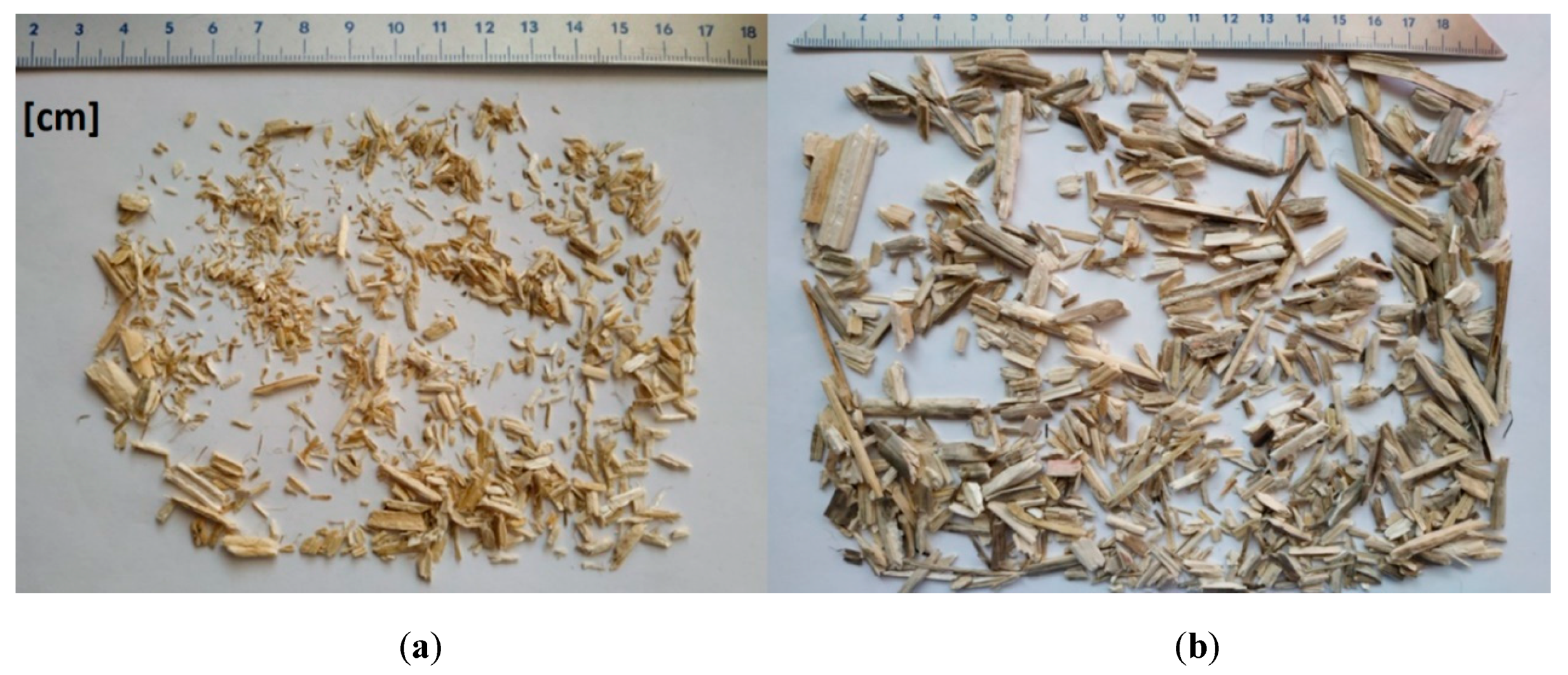
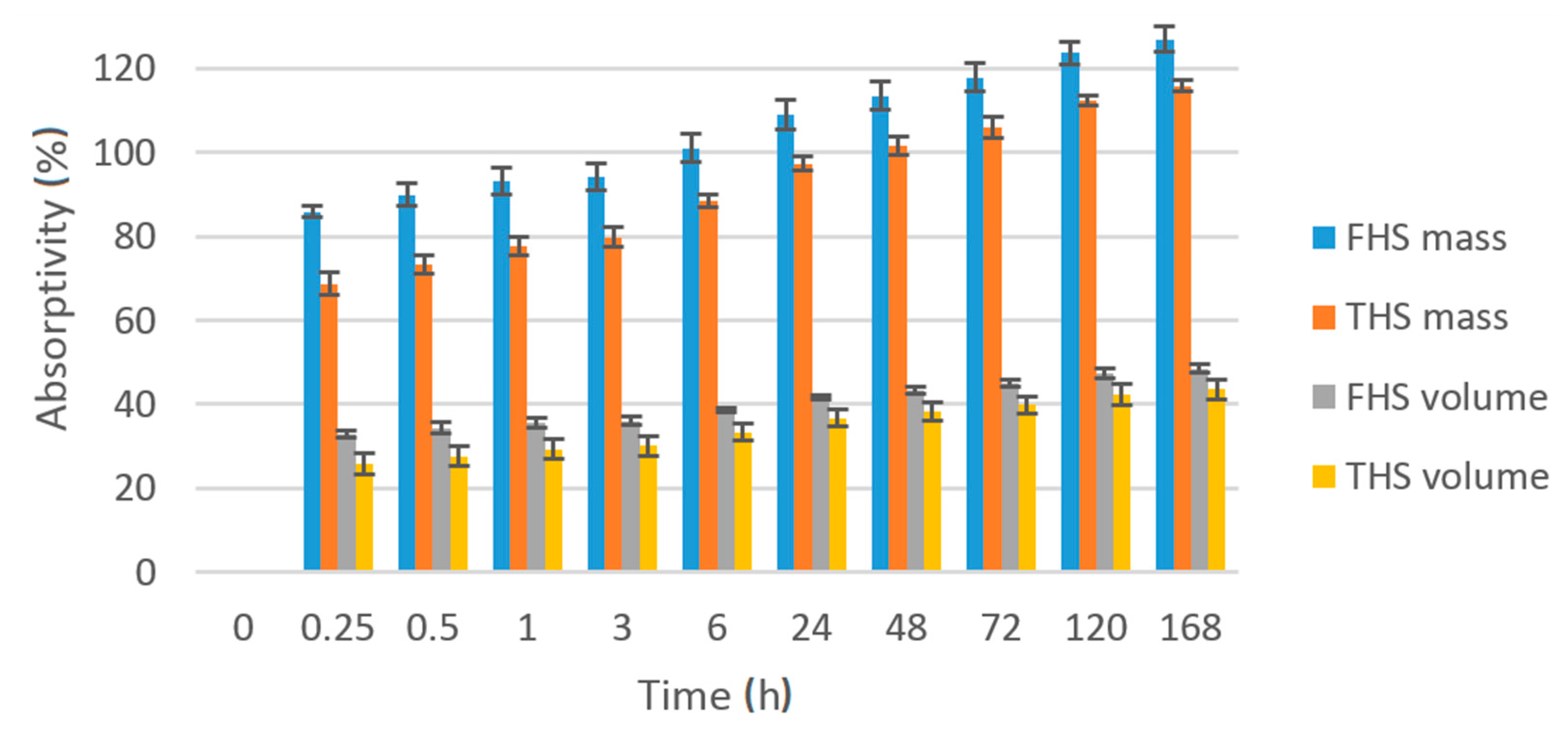


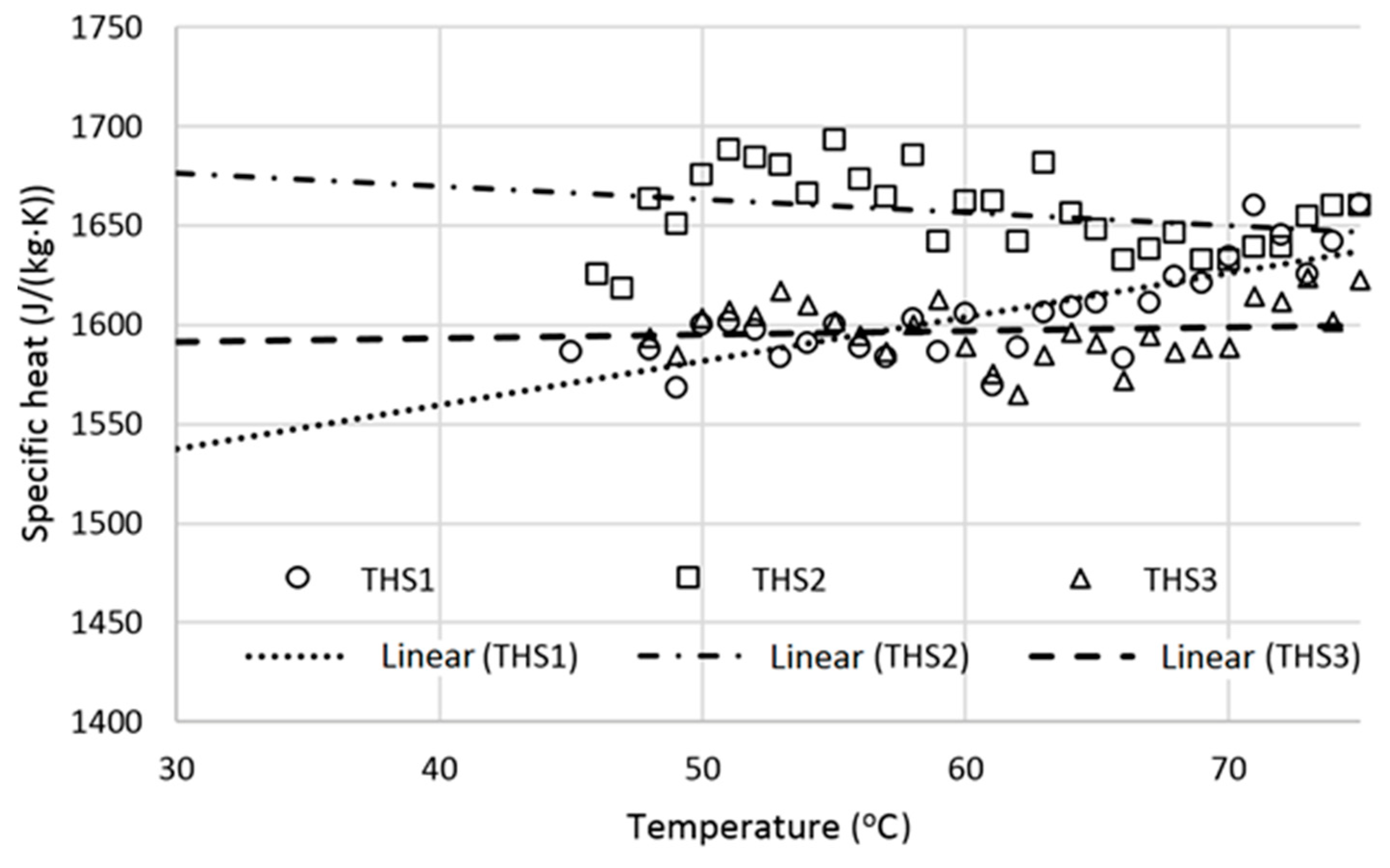
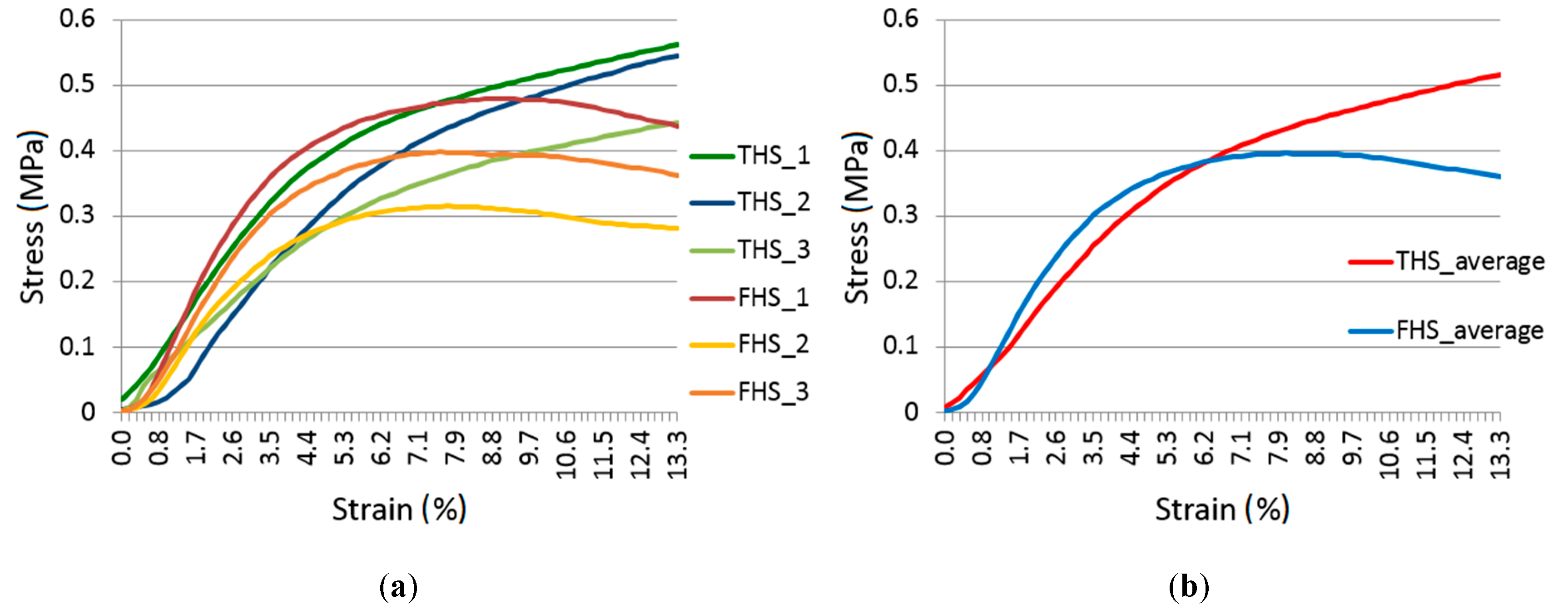
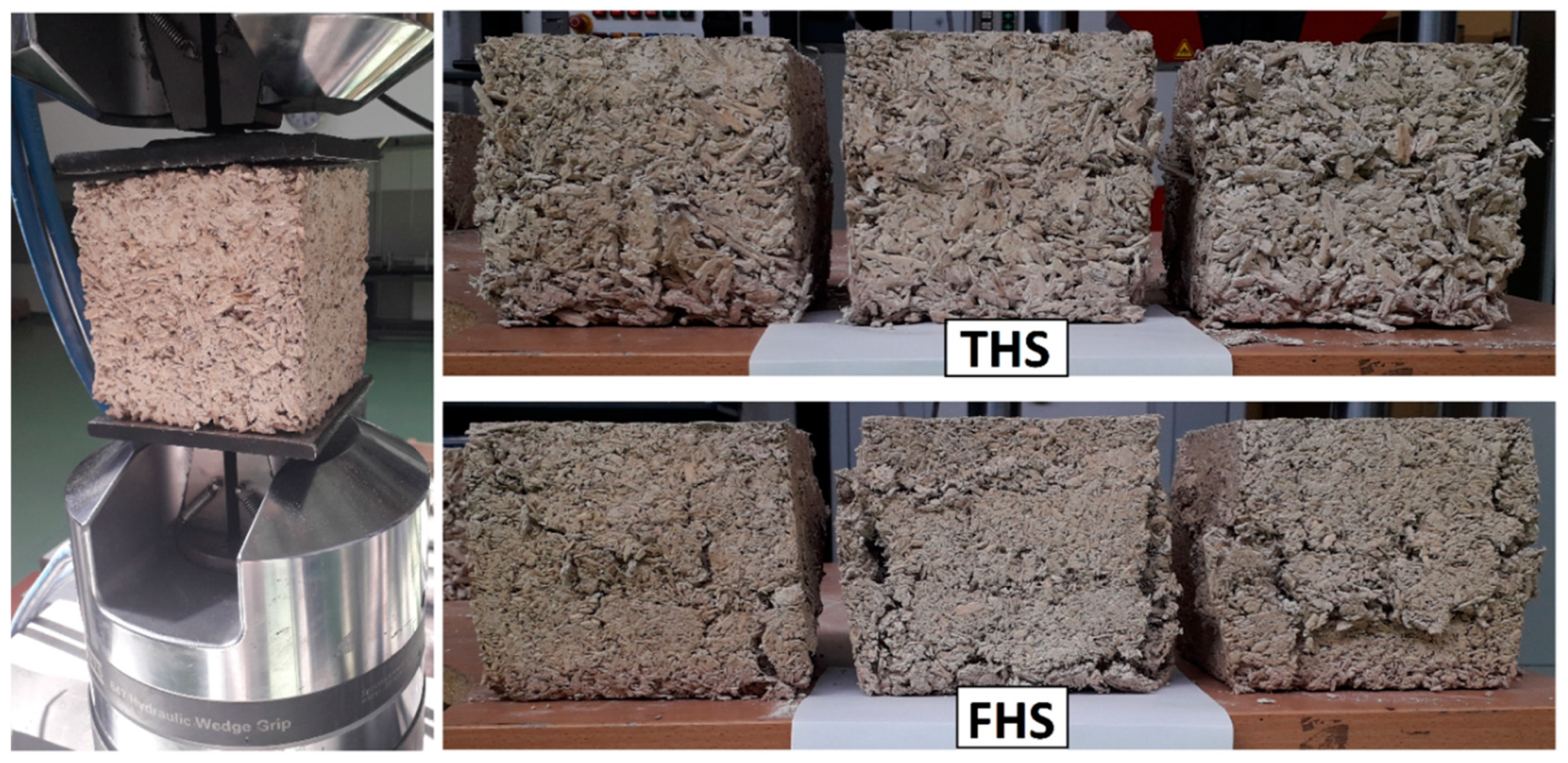

| Type of Shives | Fraction (mm) | Average Length (mm) | Average Width (mm) | Max. Length (mm) | Max. Width (mm) |
|---|---|---|---|---|---|
| Fine | 0–12 | 2.74 | 1.42 | 11.78 | 4.55 |
| Thick | 0–50 | 8.40 | 2.68 | 47.38 | 11.77 |
| Constituents | FHS | THS | |
|---|---|---|---|
| Binder | Hydrated lime | 80% | |
| Metakaolinite | 20% | ||
| Filler | Fine hemp shives | 100% | - |
| Thick hemp shives Filler: binder weight ratio | - | 100% | |
| 1:2 | 1:2 | ||
| Additive | Methylcellulose | 0.5% by weight of the binder | |
| Water | Water/binder ratio | 1.72 | 1.63 |
| Parameter | Unit | FHS | THS |
|---|---|---|---|
| Apparent density | (kg/m3) | 382.4 | 376.9 |
| Specific density | (kg/m3) | 2152.6 | 2055.4 |
| Total porosity | (%) | 82.2 | 81.7 |
| Parameter | Unit | FHS | THS |
|---|---|---|---|
| Thermal conductivity coefficient | (W/(m∙K)) | 0.1050 | 0.0992 |
| ±Std dev. | (W/(m∙K)) | 0.0007 | 0.0009 |
| Measured Parameters | Filler/RH Condition | ||||
|---|---|---|---|---|---|
| THS | FHS | ||||
| symbol (unit) | name | 0–50% | 50–94% | 0–50% | 50–94% |
| δ (kg/(m·s·Pa)) | water vapor permeability | 1.62 × 10−11 | 3.55 × 10−11 | 1.60 × 10−11 | 4.01 × 10−11 |
| μ (-) | vapor diffusion resistance factor | 12.18 | 5.57 | 12.37 | 4.94 |
| Temperature of Measurement | Type | Specific Heat (J/(kg·K)) | ||||
|---|---|---|---|---|---|---|
| Sample 1 | Sample 2 | Sample 3 | Xavg | Std Dev. | ||
| T = 30 °C | FSH | 1667 | 1476 | 1582 | 1575 | 95.7 |
| TSH | 1537 | 1675 | 1592 | 1601 | 69.5 | |
Publisher’s Note: MDPI stays neutral with regard to jurisdictional claims in published maps and institutional affiliations. |
© 2020 by the authors. Licensee MDPI, Basel, Switzerland. This article is an open access article distributed under the terms and conditions of the Creative Commons Attribution (CC BY) license (http://creativecommons.org/licenses/by/4.0/).
Share and Cite
Brzyski, P.; Gładecki, M.; Rumińska, M.; Pietrak, K.; Kubiś, M.; Łapka, P. Influence of Hemp Shives Size on Hygro-Thermal and Mechanical Properties of a Hemp-Lime Composite. Materials 2020, 13, 5383. https://doi.org/10.3390/ma13235383
Brzyski P, Gładecki M, Rumińska M, Pietrak K, Kubiś M, Łapka P. Influence of Hemp Shives Size on Hygro-Thermal and Mechanical Properties of a Hemp-Lime Composite. Materials. 2020; 13(23):5383. https://doi.org/10.3390/ma13235383
Chicago/Turabian StyleBrzyski, Przemysław, Mateusz Gładecki, Monika Rumińska, Karol Pietrak, Michał Kubiś, and Piotr Łapka. 2020. "Influence of Hemp Shives Size on Hygro-Thermal and Mechanical Properties of a Hemp-Lime Composite" Materials 13, no. 23: 5383. https://doi.org/10.3390/ma13235383





